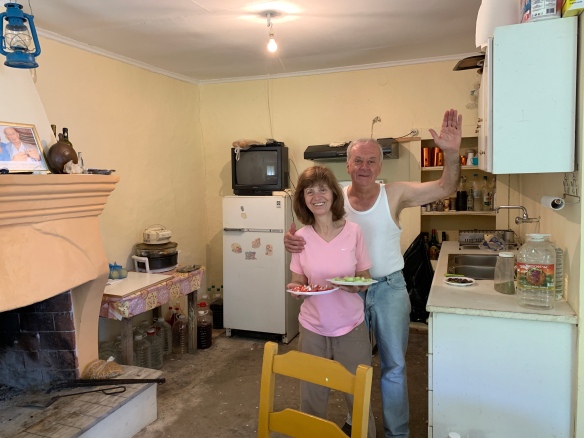On February 13, 1859, Panagiotis S. Lerikos of Agios Ioannis, Sparta, married Eleni Dimitrakakis, daughter of Giannakis, of Barsinikos. They are one set of my paternal great-great-grandparents.

Mitropolis of Sparta, Marriage Index Book; Book: Sparta, 1852-1859; Entry #524; License Date: February 13, 1859 Marriage Date: not given; Groom: Panagiotis Lerikos, no father listed; residence: Agios Ioannis; Bride: Eleni Dimitrakakis, father: Giannakis; residence: Mystras Church: Agios Georgios; First marriage for both bride and groom; Photographed by Carol Kostakos Petranek, July 2017
With this union, my family tree climbed further up the towering Taygetos mountains to the tiny village of Barsinikos where the Dimitrakakis family were original inhabitants. Barsinikos was the Ottoman name, changed to Taygeti in 1955 when the Greek government ordered the abolition of Turkish village names. Follow the red switchback road southwest of Mystras on the map below to see the location; goat and sheep trails eventually became paths, which today are roads, paved and unpaved. Yes, I do drive that road and yes, it is scary!
I visited my “new” cousin, Joanne Dimitrakakis who was born in Barsinikos, and spent a peaceful afternoon on top of the world.
We had lunch at the home of Christos Kakaletris, descendant of another original Barsinikos family. During Ottoman occupation, natives fled into the highest possible locations for refuge. Although there was forage for their sheep and goats, there was no flat land to cultivate crops. The mountain winters and inhospitable terrain must have brought challenges that we cannot imagine. After the Revolution of 1821 when it was safe to leave, they migrated from these upper mountain settlements into lower villages: Barsinikos families relocated to Mystras, Parori and Magoula.

Lunch with Joanne and Christos at his ancestral home in Barsinikos. This is the second floor. The lower level was a taverna operated by his father and grandfather.
The marriage record above gives Eleni’s residence as Mystras; however, the Church of Agios Georgios is in Barsinikos. It is evident, then, that her family was originally from Barsinikos (as she married there), but she had already left and was living in Mystras by 1859. The original church which the Dimitrakakis family would have helped to establish was one small room, and this larger church was built in the early 1900s. There is a date of August 1918 on an icon frame.
Along with the requisite church, Barsinikos had a one-room schoolhouse which Joanne attended as a child. It closed in 1965 due to lack of students.
Although the families of Barsinikos have left and the village is now deserted, many like Christos and Joanne have kept their ancestral homes. During religious holidays, summers and festivals, people return. They sit on verandas and absorb the breathtaking vistas and cool mountain air which sustained their parents and grandparents. Although life has changed, their heritage is preserved.




























































